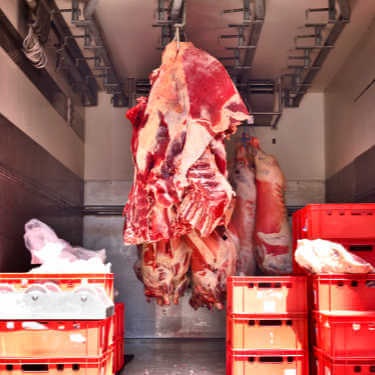Beef is a big deal in California. With more than 5.2 million cows in the state, 9 percent of the U.S. total, you’ll find that moving meat is also big business for freight companies and brokers. Learn how to ship meat in bulk and get your beef on the road by the truckload.
When you’re thinking about how to ship meat, you need to be aware that meat and beef are highly perishable. This means you need to take a few precautions to get your shipment of meat to its destination fresh and intact. Things to consider when shipping beef and meat include:
Truckload shipping for meat and beef is an option when you’re moving a large amount of meat in bulk freight. Working with the right broker and carrier can help you take care of the shipping process efficiently.
The basics to shipping meat are fairly simple. There are three main things to think about when considering how to ship meat in bulk.
Shipping perishable items like beef and meat involve a refrigerated trailer. To prevent the growth of bacteria, beef, meat and poultry need to maintain a temperature of 40 degrees during the shipping process. The shipping temperature of your beef and meat plays a big role in its stability, but it can also play a big role in the shipping cost. Beef and meat move in refrigerated trucks, also often called reefer trucks.

When you’re moving perishable freight like meat and beef, you need to be aware of its tight delivery window. When planning a shipment, it is essential to be aware of the stability requirements and speed to avoid spoilage and make sure products arrive on time. It’s also important to be aware of transit time.
Even though your freight is traveling in a temperature-controlled reefer trailer, the packaging is important. The right packaging can reduce the transfer of heat and keep your product fresh. You might consider shipping meat and beef with gel coolants and dry ice. Corrugated boxes can be used, but they’ll need liners and other forms of insulation to keep the meat fresh. It’s not a good idea to ship beef and meet with regular ice, as it melts quickly.
When you have each of the above puzzle pieces figured out, you’re ready to move your meat. It is wise to work with a freight service provider or freight broker who has experience moving perishable freight, like beef or meat. Their expertise can come in handy when dealing with bumps in the road or unplanned delays.
Unsure how to ship cattle before processing? Check out our article on transporting cattle safely.
Meat and beef are perishable foods that need to be packaged carefully for shipment. The goal is to find packaging material that will keep your products at the desired temperature as it travels. Insulated boxes are essential. Other options to package your meat or beef for shipment include:
The cold shipping solution you choose will depend on factors including how much meat you are shipping (weight), the kind of insulation you use, the outdoor temperature and the transit time.
Both the pork supply chain, as well as lamb and mutton, rely on similar strategies. Learn more from an expert freight partner.
With so many cows in California, beef is big business in the Golden State. Common freight routes in California for agricultural commodities run from north to south and from south to north.
California is a busy place for truckload shipments of beef and meat. Most parts of California enjoy a mild, temperate climate, so agricultural freight moves easily up and down the state’s highways. California’s highways are among the best in the nation, and they connect to seaports, railway hubs and more.
Additionally, California has major international seaports in Los Angeles and San Francisco, along with an international border with Mexico. This makes the state a logistics hub.

Major cities for truckload shipping in California include:
Overnight or second-day delivery might be an option when you’re moving a truckload of perishable freight like beef or meat within California. Your freight broker can help you weigh options and find the best choice for your shipment.
Figuring out how to ship meat in bulk and shipping freight from California to Texas and other states doesn’t have to be a headache. When you need to run a shipment of perishable freight, like meat and beef, in California, you need an experienced broker who can pair you with a carrier to get it there on time and intact. Let R+L Global Logistics make moving meat in California easy for you. With top-tier customer service, the latest technology and competitive rates, plan to make your next California beef shipment with R+L Global.
R+L Global Logistics
315 NE 14th St., Ocala, FL 34470